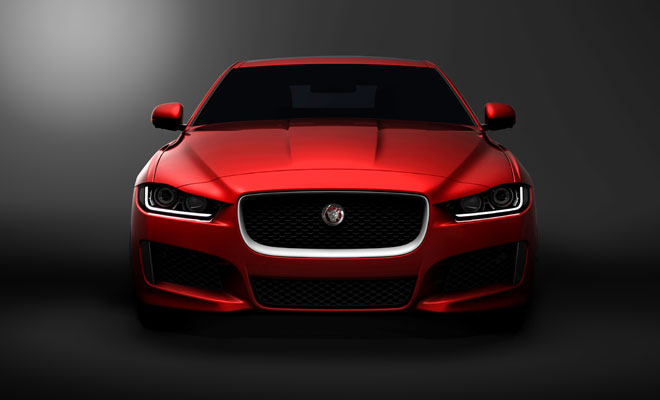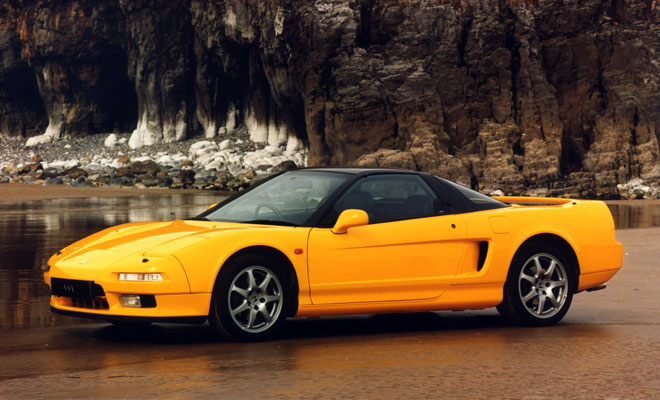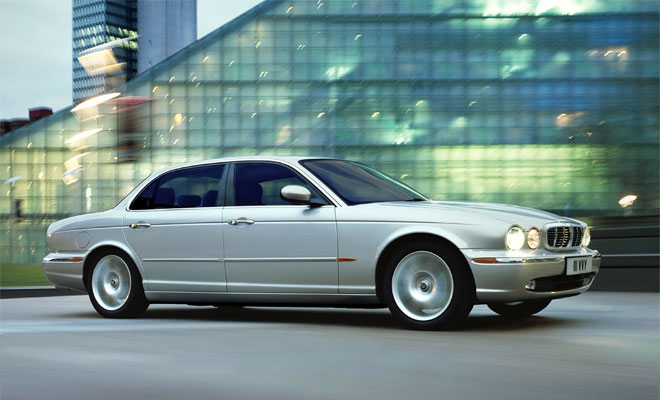by Lem Bingley 
Next week, Jaguar will whip the covers off its new XE saloon, the first model from the manufacturer to dip below 100g/km. That translates to combined-cycle fuel economy of over 75mpg, an impressive milestone for a medium-sized saloon that will have to be both well equipped and reasonably speedy if it’s to compete with BMW’s 3-Series, Mercedes’ C-Class and Audi’s A4.
The newly arrived Mercedes manages an impressive 102g/km and 72.4mpg in its most efficient diesel format, with the C300 model dropping even lower to 94g/km and 78.5mpg with the assistance of a hybrid battery and motor.
Jaguar, by contrast, will slip below 100g/km without recourse to batteries, primarily through weight saving. The new XE will be a hybrid, but not of the diesel-electric variety. Instead it will rely on a crossbreed combination of 75% aluminium and 25% steel in its chassis, cutting heft and therefore fuel consumption, with the added benefit of increased agility.

The XE’s aluminium structure will be a first for this size and style of car – middle-range cars, even premium ones, are usually fashioned from steel for reasons of cost. Roadgoing aluminium vehicles aren’t new, but they have typically been limited to larger and more expensive models or to sporting cars where reduced weight matters most. Jaguar’s own XJ limousine, XK coupé and F-Type sports car are all built from aluminium, whereas the current XF saloon is steel.
One of the reasons aluminium is expensive is that it sucks up a lot of energy in its production from raw ores – several times the amount needed to make the equivalent sheet steel. That also brings added debt to the lifecycle CO2 of the resulting car. Recycled aluminium is much better, cutting energy debt by 95%, but recycled alloys typically aren’t suitable for safety-critical structures like a car chassis. Engineers need predictable strength and durability rather than a patchy blend of former bottle caps and Coke cans.
However, Jaguar has worked with its aluminium supplier to correct that situation. About 50% of the aluminium used by Jaguar is recycled, though not of the Coke-can variety. Instead, off-cuts from Jaguar’s factory are collected, sorted, and returned to source, where they are melted down and mixed with new material to create subsequent batches of aluminium sheet. As a result, high-quality material stays within a closed loop of known provenance.
Jaguar has plans to increase the ratio to 75% recycled by 2020, though that will require collecting scrap aluminium from other sources.
Aluminium is undoubtedly wonderful stuff, but you don’t have to wait for the XE to enjoy it. Below are five fantastic lightweight cars that you can rush out and buy today.

A mid-engined, 3.0-litre V6 sports car may not provide the last word in economical transport, but the gracefully ageing Honda NSX was the first production car to feature an all-aluminium monocoque chassis.
The NSX feels appropriately light and delicate to drive, with quick responses and a free-revving engine. But be suitably warned. It hails from a time before computerised stability control, so you’ll need iron self control or exceedingly sharp reflexes to keep an NSX pointing in the right direction in the wet.
When was it built? 1990 to 2005
How many are left? About 240 are currently in the UK
What will it cost? A budget of £25,000 to £30,000 should get you a good one from a specialist dealer

The curvy bodywork of Lotus’s lithe little Elise may be plastic, but the structural chassis underneath is lightweight aluminium alloy. A selection of flat sheets and extruded alloy sections are bonded and riveted together – the word “bonded” sounding more reassuring than “glued”. Fortunately, adhesive and aluminium cling together like chewing gum and shoes, resulting in a stronger join than would be got from welding, according to Lotus.
As well as underpinning several generations of Elise, versions of the same Lotus chassis can be found under the skin of the Vauxhall VX220 and Tesla Roadster.
When was it built? Series 1 from 1996, Series 2 from 2001 to the present
How many are left? About 5,200 are currently registered in the UK
What will it cost? We found a selection of Lotus Elise options via Exchange & Mart, starting at about £11,000

Audi’s attempt to make an upmarket small car led to an all-aluminium design, helping the A2 to provide both excellent economy and lively handling.
The A2 relied on an aluminium framework of cast and extruded components, laser-welded together, clad in aluminium panels of variable thickness to provide strength where it was needed. The same approach had previously been used with Audi’s contemporary A8 saloon, which was built in much smaller numbers. According to Audi, the A2’s body weighed 40% less than a steel equivalent.
However, expense and divisive styling meant the A2 was not a great sales success. Vorsprung durch Technik didn’t prove profitable in the small car sector, and the subsequent A1 arrived as an unremarkable steel-bodied hatchback.
When was it built? 1999 to 2005
How many are left? About 17,000 in the UK
What will it cost? Useable cars can be found for £1,500 but the youngest and most pristine examples will be more than £5,000

The engineers who created the original Honda Insight were aiming to build the most efficient production car in the world, so it’s no surprise that they produced a strikingly streamlined design fashioned from lightweight materials.
Body panels including the roof, floor, wheel wells, rear wings and bulkhead are aluminium, welded into place and adding strength to an underlying framework. The doors and bonnet are alloy too, though the front wings are plastic.
While the earlier NSX used mostly sheet metal stamped into shape and joined together, roughly 40% of the Insight’s aluminium was extruded or cast into shape before assembly. The result was a body that weighed roughly half as much as a contemporary 3-door Civic bodyshell, with markedly superior resistance to twisting and bending.
When was it built? 1999 to 2006
How many are left? Just over 200 in the UK
What will it cost? Expect to pay between £3,000 and £5,000, according to condition

The third-generation Jaguar XJ (known as X350 internally) might have looked as if it rolled straight off the ark, but it was a remarkably high-tech vehicle and a complete departure from the prior car of the same name, which it closely resembled.
The body was largely made from sheets of aluminium alloy, stamped into shape and joined together with lots of rivets and glue, rather than welds. The result was reportedly 40% lighter and 60% stiffer than its predecessor
The current XJ, with sleeker lines giving it a much more modern appearance, remains very similar to the revolutionary X350 under the skin.
When was it built? 2003 to 2009
How many are left? Lots
What will it cost? From £3,600 for the first of the aluminium cars to £20,000 for the last of the old-style Jags



